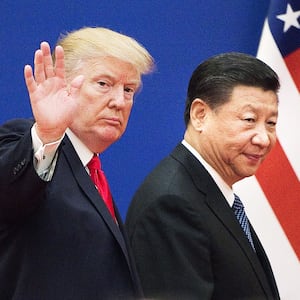War between the U.S. and China, inconceivable just a decade ago, is now a regular topic of analysis and conversation.
Lt. Gen. Ben Hodges, the just-retired commander of the U.S. Army in Europe, suggested conflict with the People’s Republic could come soon. “I think in 15 years—it’s not inevitable—but it is a very strong likelihood that we will be at war with China,” Hodges said last Wednesday at the Warsaw Security Forum.
His stark assessment was followed, as it happened, by bellicose statements from Chinese ruler Xi Jinping and his defense minister.
So I called Hodges over the weekend for clarification, and his estimation of the situation was in many respects even more grim than his remarks in Poland.
What could be even worse than a Chinese attack? A simultaneous Russian assault in Europe on top of a Chinese attack is the worst “worst case.” The United States just isn’t ready to fight Russia and China in a two-front struggle.
“My real audience that I was trying to reach with that comment there in Warsaw was our European allies,” said Hodges. “I was trying to tell them, ‘Hey look, we do not have the capacity in the United States to be able to deter Russia, to be the bulwark against possible Russian aggression, and deal with China.’” The general was, in short, reminding Europeans that the bulk of American military assets, in the event of twin crises, are “going to be focused in the Pacific.”
This stark assessment came at the same time Chinese ruler Xi Jinping and the country’s defense minister issued bellicose statements.
On Thursday, Chinese Defense Minister Wei Fenghe, at the Xiangshan Forum in Beijing, noted, “China is the only big nation in the world that is not unified.” He said the “islands in the South China Sea have long been China’s territory” and warned “we can’t afford to lose a single inch of them.” And on another sovereignty claim he said this: “If someone tries to separate Taiwan from China, the Chinese armed forces will take action at any price.”
Also Thursday, Chinese ruler Xi Jinping ordered the Southern Theater Command of the People’s Liberation Army (PLA), which covers both the South China Sea and Taiwan, to “prepare for war.” Because no country is threatening China, Xi must be thinking one option is to launch an attack in the not too distant future.
“President Xi’s exhortation to the PLA’s Southern Theater Command leadership to ‘prepare for war’ is not a new directive,” James Fanell, a leading naval commentator, told The Daily Beast. “Like his predecessor, Xi has ordered the People’s Liberation Army to be able to have the capability to take Taiwan by military force by 2020. We are now just 14 months from 2020; it is time for America to take these statements seriously and prepare for the worst case.”
The fundamental problem at the moment is that, for all its size and capability, America’s military is not large enough to meet commitments. As Hodges noted, “The fact is the Navy is overstretched right now, the Army is overstretched right now, the Air Force is overstretched right now.”
At the moment, the Navy is at 286 Deployable Battle Force Ships. That, according to those who study China’s navy, is too small. President Donald Trump has called for a 355-ship fleet. Fanell argues for a 600-ship one.
A doubling of the fleet, however, would seem impossible within budgetary constraints. Trump has just ordered a reduction in the Pentagon budget to $700 billion for Fiscal Year 2020.
As big as that number is, Russia, and especially China, are rearming. The PLA Navy already has more vessels than the U.S. according to some counts, and it is adding a new warship every other month. Moreover, Beijing has militarized to an unprecedented degree its coast guard and the “little blue men” of its fishing fleets. In a conflict, Xi will be able to bring to bear all his forces at the point of attack, and the U.S. Navy will be spread around the globe.
You go to war, as is often said, with the military you have, not necessarily the one you need. “If you think of World War II, all of the events that led up to the beginning of where the U.S. went into World War II, actually it was years, thank goodness the U.S. Navy was anticipating a potential war with Japan so that they were already developing the right kind, we had all these aircraft carriers,” Hodges said.
“We had,” he said, “begun to transition from a battleship-based navy to one that had aircraft carriers. If we hadn’t done that, we would have been in much worse condition. And so it takes time to develop, to build the necessary ships, to have the missile-defense capabilities, to establish partnerships and alliances.”
In an echo of the 1930s, the U.S. Navy is not now configured to deal well with expected challenges. As Jerry Hendrix points out in The National Review, America’s fleet does not have, among other things, carrier-based drones able to hit Chinese targets at great standoff distances.
And that brings us back to Hodges’ most striking words in Warsaw: the 15-year time frame. As he told me, “It’s based on just a professional assessment of how long it takes to develop certain capabilities, both in terms of weapons systems but also when you think about the economic factors, the natural resources, all those kinds of things.”
That time frame roughly coincides with what Fanell and others call the “Decade of Concern,” the 2020s. China’s flag and mid-ranking officers, nourished in virulent anti-Americanism, are itching to fight Americans, and the circumstances are aligning so they just might get that opportunity. Xi Jinping has staked his career on taking on America.
Unfortunately, he may see a closing window of opportunity to do so. A crumbling economy, tumbling demography, and deteriorating environment might lead him to believe that he must act now or lose his chance forever to accomplish historic goals.
Xi’s biggest problem is that, as absolute leader, he must now accept total responsibility for worsening relations with the United States and serious dislocations at home. There is, simply, no one else to blame.
And because he has de-institutionalized the Communist Party—he has junked all the rules that constrained his power—he is vulnerable to no-holds-barred retaliation from his political enemies. Xi, during his half-decade atop the Chinese political system, has increased the cost of losing political struggles.
China’s ruler, therefore, has no Plan B, because having to back down in the face of U.S. pressure could lead him to lose power, his freedom, and his life.
For the first time in more than a generation, China has a leader who has an incentive to risk it all. Xi Jinping, therefore, could take China over the cliff with him.
We are now entering that decade of great concern.







